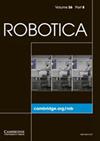Four-bar linkage reconfigurable robotic wheel: Design, kinematic analysis, and experimental validation for adaptive size modification
IF 2.7
4区 计算机科学
Q3 ROBOTICS
引用次数: 0
Abstract
This article presents the development of a robot capable of modifying its size through a wheel reconfiguration strategy. The reconfigurable wheel design is based on a four-bar retractable mechanism that achieves variation of the effective radius of the wheel. A reconfiguration index is introduced based on the number of retractable mechanisms that predicts the radius of configuration according to the number of mechanisms implemented in the wheel. The kinematics of the retractable mechanism is studied to determine the theoretical reconfiguration radius during the transformation process, it is also evaluated numerically with the help of the GeoGebra software, and it is validated experimentally by image analysis using the Tracker software. The transformation process of the robot is investigated through an analysis of forces that consider the wheel in contact with the obstacle, the calculation of the wheel torque and the height of the obstacle to be overcome are presented. On the other hand, the experimental validation of the robot reconfiguration process is presented through the percentage of success shown by the robot to overcome obstacles of 50, 75, 100 and 125 mm. In addition, measurements of energy consumption during the transformation process are reported. Reconfigurable wheels, capable of adapting their size, offer innovative solutions to various challenges across different applications such as robotic exploration and search and rescue missions to industrial settings. Some key issues that these wheels can address include terrain adaptability enhancing a robot’s mobility over uneven surfaces, or obstacles; enhanced robotic design; cost-effective design; space efficiency; and versatility in applications.四杆联动可重构机器人轮:自适应尺寸调整的设计、运动学分析和实验验证
本文介绍了一种能够通过轮子重新配置策略改变自身大小的机器人的开发情况。可重新配置的轮子设计基于一个四杆可伸缩机构,可实现轮子有效半径的变化。根据可伸缩机构的数量引入了一个重新配置指数,该指数可根据车轮中实施的机构数量预测配置半径。研究了可伸缩机构的运动学,以确定变换过程中的理论重新配置半径,还借助 GeoGebra 软件对其进行了数值评估,并使用 Tracker 软件通过图像分析对其进行了实验验证。通过分析车轮与障碍物接触时的受力情况,研究了机器人的变形过程,并介绍了车轮扭矩和需要克服的障碍物高度的计算方法。另一方面,通过机器人克服 50、75、100 和 125 毫米障碍物的成功率,对机器人重组过程进行了实验验证。此外,还报告了变形过程中的能耗测量结果。可重构轮子能够调整其尺寸,为机器人探索、搜救任务和工业环境等不同应用领域的各种挑战提供了创新解决方案。这些轮子可以解决的一些关键问题包括:地形适应性,增强机器人在不平路面或障碍物上的机动性;增强机器人设计;具有成本效益的设计;空间效率;以及应用的多样性。
本文章由计算机程序翻译,如有差异,请以英文原文为准。
求助全文
约1分钟内获得全文
求助全文
来源期刊

Robotica
工程技术-机器人学
CiteScore
4.50
自引率
22.20%
发文量
181
审稿时长
9.9 months
期刊介绍:
Robotica is a forum for the multidisciplinary subject of robotics and encourages developments, applications and research in this important field of automation and robotics with regard to industry, health, education and economic and social aspects of relevance. Coverage includes activities in hostile environments, applications in the service and manufacturing industries, biological robotics, dynamics and kinematics involved in robot design and uses, on-line robots, robot task planning, rehabilitation robotics, sensory perception, software in the widest sense, particularly in respect of programming languages and links with CAD/CAM systems, telerobotics and various other areas. In addition, interest is focused on various Artificial Intelligence topics of theoretical and practical interest.
 求助内容:
求助内容: 应助结果提醒方式:
应助结果提醒方式:


